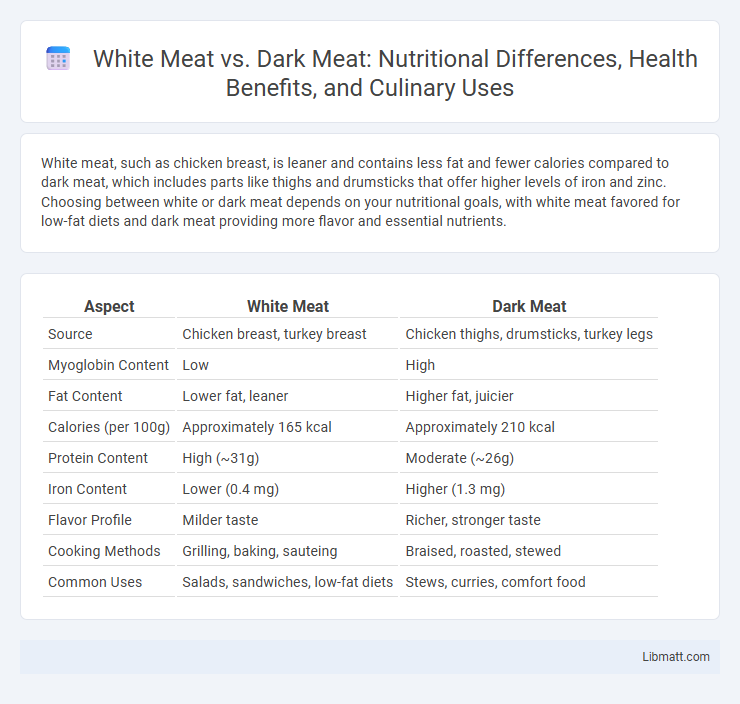White meat, such as chicken breast, is leaner and contains less fat and fewer calories compared to dark meat, which includes parts like thighs and drumsticks that offer higher levels of iron and zinc. Choosing between white or dark meat depends on your nutritional goals, with white meat favored for low-fat diets and dark meat providing more flavor and essential nutrients.
Table of Comparison
| Aspect | White Meat | Dark Meat |
|---|---|---|
| Source | Chicken breast, turkey breast | Chicken thighs, drumsticks, turkey legs |
| Myoglobin Content | Low | High |
| Fat Content | Lower fat, leaner | Higher fat, juicier |
| Calories (per 100g) | Approximately 165 kcal | Approximately 210 kcal |
| Protein Content | High (~31g) | Moderate (~26g) |
| Iron Content | Lower (0.4 mg) | Higher (1.3 mg) |
| Flavor Profile | Milder taste | Richer, stronger taste |
| Cooking Methods | Grilling, baking, sauteing | Braised, roasted, stewed |
| Common Uses | Salads, sandwiches, low-fat diets | Stews, curries, comfort food |
Introduction to White Meat and Dark Meat
White meat, primarily found in the breast and wing muscles of poultry, is characterized by its lighter color, lower fat content, and milder flavor due to fewer myoglobin proteins. Dark meat, located in the legs and thighs, contains higher levels of myoglobin, offering a richer taste, increased fat, and more moisture, making it juicier and more flavorful. Nutritional differences between white and dark meat include varying concentrations of calories, fat, iron, and protein, influencing dietary choices based on health and culinary preferences.
Nutritional Differences: White Meat vs Dark Meat
White meat, primarily found in chicken breasts, is lower in fat and calories but higher in protein compared to dark meat from chicken thighs and drumsticks. Dark meat contains more iron, zinc, and B vitamins, especially vitamin B6 and niacin, due to its higher myoglobin content. The fat content in dark meat contributes to a richer flavor and increased calorie count, making it a more energy-dense option.
Flavor Profiles and Culinary Uses
White meat offers a mild, tender flavor ideal for delicate dishes like chicken breasts in salads or stir-fries, while dark meat features a richer, more robust taste with higher fat content suited for slow-cooked meals and roasting. You can enhance white meat by pairing it with light herbs and citrus, whereas dark meat pairs well with bold spices and savory marinades. Understanding these flavor profiles helps optimize your culinary creations by matching meat types to appropriate cooking methods and seasonings.
Health Benefits of White Meat
White meat, primarily found in poultry like chicken and turkey, offers a lean source of protein that is low in saturated fat and calories, supporting heart health and weight management. Rich in essential nutrients such as B vitamins and selenium, white meat enhances metabolism and immune function. Consuming white meat can reduce the risk of cardiovascular diseases and improve muscle development due to its favorable fat profile and high bioavailability of protein.
Health Benefits of Dark Meat
Dark meat contains higher levels of essential nutrients such as iron, zinc, and B vitamins, which support immune function and energy metabolism. Its increased fat content includes beneficial monounsaturated and polyunsaturated fats that help maintain healthy cholesterol levels. The richness in myoglobin also provides greater antioxidant properties, contributing to overall health benefits.
Cooking Methods and Best Practices
White meat, such as chicken breast, benefits from quick, high-heat cooking methods like grilling, roasting, or sauteing to maintain its tenderness and moisture. Dark meat, found in legs and thighs, is best suited for slow cooking techniques like braising, stewing, or smoking, which break down connective tissue and enhance flavor. You can maximize juiciness and taste by selecting the appropriate method based on the meat's texture and fat content.
Common Myths and Misconceptions
White meat is often mislabeled as healthier than dark meat, but dark meat contains higher levels of iron, zinc, and B vitamins essential for your body. Common myths suggest dark meat is always fattier and less nutritious, yet it provides more omega-3 and conjugated linoleic acid, which support heart health. Understanding these nutritional differences helps you make informed choices based on taste and dietary needs rather than misconceptions.
Calorie and Fat Content Comparison
White meat, such as chicken breast, typically contains fewer calories and less fat compared to dark meat found in chicken thighs or drumsticks. On average, a 3-ounce serving of skinless white meat has about 140 calories and 3 grams of fat, whereas the same portion of dark meat contains around 180 calories and 8 grams of fat. Choosing white meat can help you manage calorie intake and reduce fat consumption more effectively.
Choosing the Right Meat for Your Diet
White meat, such as chicken breast and turkey, is lower in fat and calories, making it ideal for weight management and lean protein diets. Dark meat, found in thighs and drumsticks, contains higher levels of iron, zinc, and B vitamins, benefiting those needing to boost nutrient intake. Selecting between white and dark meat depends on dietary goals, with white meat offering lean protein and dark meat providing richer nutrients and flavor.
Conclusion: Which Meat is Better for You?
White meat, such as chicken breast, is generally lower in fat and calories, making it a leaner option ideal for those seeking weight management or heart-healthy diets. Dark meat contains more iron, zinc, and B vitamins, providing greater nutritional density and beneficial antioxidants that support immune function. Your choice between white and dark meat depends on your dietary goals--opt for white meat for lower fat intake and dark meat for richer nutrients.
White Meat vs Dark Meat Infographic

 libmatt.com
libmatt.com